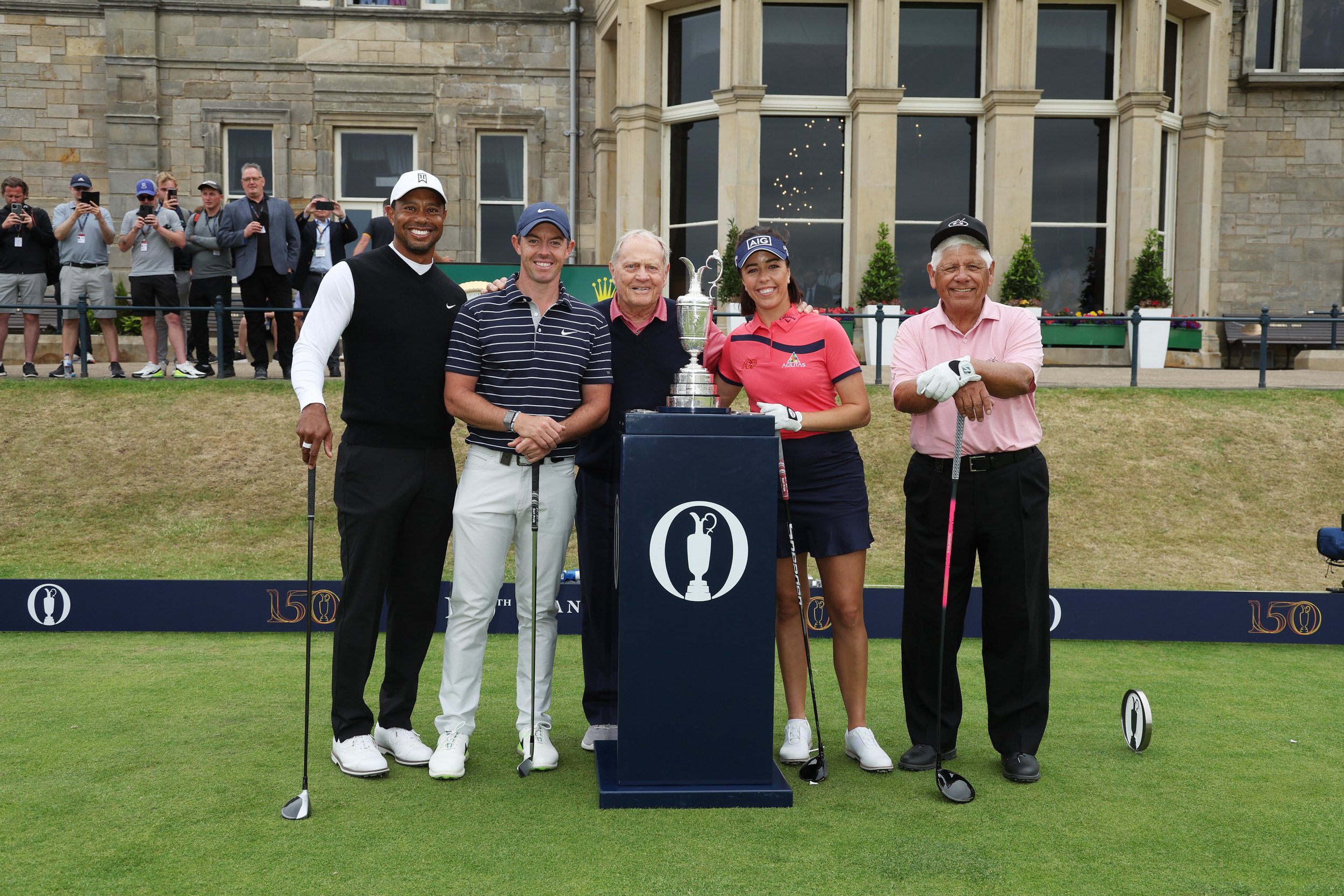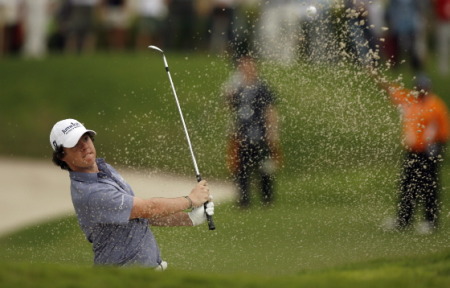The real Rory? "I just look at him as a human being"
The real Rory McIlroy? With the children from the Boys and Girls Club of Tucson at the WGC Accenture Match Play Championship. Picture: Fran Caffrey / www.golffile.ie
American milk cartons often features pleas for information about tragic cases of child abduction — mysterious tales of disappearances that would soften even the hardest of hearts. What then, one wonders, has become of the curly haired wonder-kind who wowed the world with his golf when he burst on the scene as an amateur and won the Silver Medal in the Open at Carnoustie in 2007?
What happened to the Rory McIlroy that had America and the world eating out of his hand with the way he so manfully took his 2011 Masters collapse on the chin?
Why aren’t we hearing about the fact that he spent all of last Saturday, not practicing for The Open at Muirfield but making a dream come true for 16-year old Spanish boy suffering from cancer by playing a round of golf with him at nearby Archerfield?
Rory McIlroy bends a club in frustration at the US Open in June.
Rory McIlroy, supporting Northern Ireland Cancer Fund for children, shows seven-year old James Banmatyne how to grip the club at the Abu Dhabi HSBC Golf Championship. Picture: Fran Caffrey/www.golffile.ie
As Barry Funston, the newly appointed head of The Rory Foundation said at Muirfield this week: “I always look at him just as the young man I know. The young kid that I knew.
“I don’t look at him as this golfing superstar. I play less attention to how wonderful his golf is or how not so good his golf is and just look at him as a human being. And he has not changed at all. He is exactly the same young man. Rory is a responsible, decent young man and he realises the necessity to give back and he wants to give back.”
Asked if he thought McIlroy receives a fair rap in the media, he replied: “No, I don’t. I think he is treated harshly. But I guess that is the nature of the world in which we live. We don’t seem to rejoice and celebrate success. We seem to always want to knock people when things are not going they way it should for them. So I don’t. I don’t think so. I think he is treated quite harshly.”
Whatever about the recent deterioration in his game, McIlroy’s image has suffered more grievous bodily harm than the Picture of Dorian Gray over the past six months.
The latest blow came in a snapshot of Ireland’s changing perception of the two-time major winner in The New York Times last Saturday
“McIlroy, a Native Son, Divides Ireland,” ran the headline on a piece by staff golf writer Karen Crouse, who travelled to the Irish Open last month to try and unravel the knots that McIlroy appears to have tied himself up in over the past few years, leaving Ireland ambivalent in its attitude to the former world No 1.
“In pubs and cabs and on the Carton House course,” the piece ran, “McIlroy was variously described as ‘a spoiled brat’ and ‘a snob,’ and hailed as being from ‘a leafy loyalist suburb.’”
In short, it was a publicist’s nightmare.
In bravely attempting to unravel this astounding nest of contradictions, The New York Times’ piece has simply added to the wave of negativity surrounding the greatest golfing talent to emerge from this island.
Given the mystery surrounding McIlroy’s unofficial but very real split from his management group of less than two years, Horizon Sports, there was a deafening silence in reply to an article that while well-meaning, does little but do more damage to the world number two.
Rory McIlroy and James Banmatyne. Picture: Fran Caffrey/www.golffile.ie.After all, The New York Times is third-largest newspaper in the US behind The Wall Street Journal and USA Today. Its website is the up there with the most popular in America and at one point received more than 30 million unique visitors per month.
Its content is syndicated to thousands to news outlets around the globe with the McIlroy story reaching the South China Morning Post and Gulf News, to name just two sources.
Criticism of his behaviour has been widespread with former major winners such as Nick Faldo describing as “dangerous” his decision to change all 14 clubs in the bag or the general condemnation of his decision to walk out midway through the Honda Classic and his club-mangling antics in the recent US Open.
While he is still officially managed by Horizon, in reality he is looking after his own affairs. And so it is no surprise that an already difficult media relations challenge has been allowed to drift aimlessly in a sea of news print.
Graeme McDowell suffered when he became a major winner and recognises - albeit on a different scale - the huge challenges facing his former stablemate since his fame exploded with his rise to world No 1 last year.
“You don’t just wake up one day and go, right, okay, I’m ready to be that guy now,” McDowell said recently. “I can’t imagine what Rory has gone through this year. He’s now one of the most recognised athletes in the world, tossed in there with the Tiger Woods and Federers and Nadal s and all of these amazing Nike athletes that we read about week‑in and week‑out.”
Like athletes mentioned above, McIlroy set his own charitable foundation - The Rory Foundation - to promote charitable causes working for children.
It began with the Six Bags project with a children’s charity receiving publicity on his bag for the first six events of the season but little has been heard about his initiatives since then as his management problems bubbled under the surface.
Yet behind the scenes, McIlroy continues to think deeply about his power to make a difference and has appointed a lifelong family friend, Holywood native Barry Funston who left his role as a successful executive for an Irish oil company to take charge of the Rory Foundation last May.
McIlroy has already engaged with his sponsors Nike and Bose to do things that will help grow his Foundation. Exactly how much was raised by the Six Bags project and the auctioning off of the golf bags will not be made public but the knock on effect for organisations such the Northern Ireland Cancer Fund for Children has been to multiply that initial sum raised ten-fold thanks to the clout an association with McIlroy brings.
Hundreds of thousands have been raised for the related charities and Bose has agreed to help the Northern Ireland Cancer Fund for Children in fitting out a new, 12-bedroom respite centre in Newcastle, Co Down with a home cinema and other sound systems.
Playing golf with the Spanish teenager suffering from cancer is something McIlroy was more than pleased to do.
“Rory gets a lot out of these days and it’s a side to Rory that people don’t actually see,” Funston said. “He doesn’t do it to court publicity.
“As he said to me when we were discussing the vision for his Foundation, ‘I totally empathise with children because I am a young guy myself. And I want to give something back to children’s charities.’
“The side of Rory I see isn’t the golfing side that everyone else sees. The side I see is the Rory who is a very caring, compassionate young man who is anxious that he does give back because he realises how lucky he is to play the sport that he loves and reaps the rewards.”
“The foundation is not about generating good news about Rory. He wants the foundation to be about doing good things and when we really start to drive through change I think we will certainly want to make people aware of it. But he is not doing it to help himself. He is doing it to help others.”
Driving through his own changes is proving to be a major challenge for McIlroy right now but when all the pieces finally fall into place, the results could be as spectacular as the rise to the top that’s caused him so much angst.









